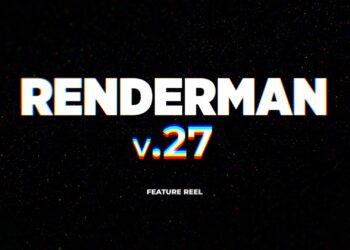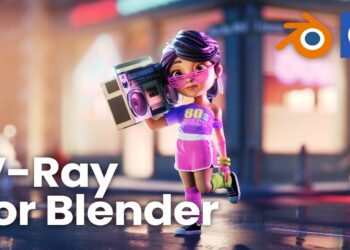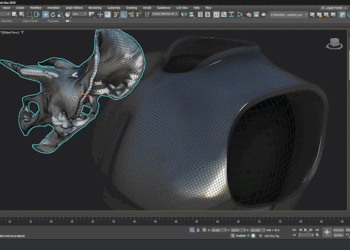Cebas has announced the latest update to Final Render, its hybrid CPU and GPU renderer. Earlier this year Cebas updated Final Render to take full advantage of CPU and GPU hardware when rendering in addition to reductions in GPU memory usage of up to 50% and 25% improvements in processing time. In Drop 2, released today, Cebas has improved speed improvements still further and extended the hybrid system with a new biased light cache it calls biasHybrid, which combines bias and unbiased techniques in a single light cache.
Cebas CEO Edwin Braun describes the new feature: “a biased rendering method has been “married” with a true unbiased spectral based rendering technology […], we have combined perfectly those traditionally contradictory rendering methods into one simple-to-use but powerful package. We have developed firstly a Lightcache that works on GI, and our users can expect even greater rendering power in future updates as we work on combining biased and unbiased path tracing to reflection, adaptive sampling, depth-of-field, motion blur, denoising and what have you.”
The new light cache is designed specifically to speed up secondary global illumination ray calculations by reducing the random noise at render time. Cebas promise that renders created with the new light cache will show little to no visual difference to fully unbiased renderings.
This drop also sees improvements to sub-surface scattering which now uses random walk techniques to enhance the speed and appearance. According to Cebas the new algorithm is “Physically accurate and lets you control the absorption of light based on its individual depth-based Wavelength Spectrum filtering. SSS works much better now with cavities and thin protrusions on the surface”.
The AI Denoiser continues to improve with full support of HDRI colour values, enabling full tone mapping operations after the fact. It also uses less memory and starts faster. Other improvements include support for 3DS Max’s native Physical Material and support for particle instancing from Thinking Particles, including on the GPU. Finally, area lights and Sky Portals have also been improved.
FinalRender is available under a rental licensing scheme priced at €24.50 a month, billed annually. You can use up to 2 GPUs with this license but unlimited GPUs and render nodes are also available each for the cost of a single additional license. Find out more on Cebas’s website.









“rental licensing scheme”
No, thanks, we have Redshift.
Plus up to 8 GPUs per license
This isn’t really a dig at Cebas, since almost every other rental scheme does it, but why list the per month pricing which you can only buy in 12 month increments. How about just €0.81 a day instead (billed annually). That is practically free!
So always €294 then, right?
I avoided Autodesk 3ds max updates for several years (2015 until now) because of the lack of updates from my favorite renderer (FinalRender) … after several years of waiting, it is very frustrating to know that new versions of FinalRender do not are fully compatible with the versions of the past. Unfortunately my network-based rendering is all based on CPUs (instead of GPUs). Could anyone give me advice on the best renderer to replace the fR? (based on CPU calculations)
Finalrender is cpu and gpu, so you wil be fine with your cpu renderfarm as well. I like quite a lot Arnold, and vray. What do you do exactly?
Corona is inexpensive especially since you can actually pay for just one month if you only have a short term need. There’s no unlimited network license but a 30 day 1 workstation and 10 node license is pretty cheap.
Flavio,
Be invited to https://www.facebook.com/events/2160233184194096/ Facebook free LIVE chat directly with Edwin Braun and you can pop all the questions you want to Edwin. 🙂
All Welcome.
Thanks.
Cedar Thokme
Cebas-Social Media
“How much it cost?”…there was upon a time when SPEED was the key for a renderer and cost was at second point of rules.
So, apart the price…is it faster than other competitors?
Salvo, we have a free test version coming soon. Keep tab @ facebook.com/rendersoftware as I am not always here. Best you test it on your system. Beta tester had anything from GPU kernel memory usage reduced by up to 50% (newer NVIDIA cards). True unbiased CPU and GPU processing time has been sped up by up to 25%. Considerable fewer passes needed to achieve a cleaner result in less time. Depending on the individual scene setup rendering speedups of 2 times or more are not unusual to see. That’s what we know. You have to test your system.
thanks for answering, hope in a “like fstorm only watermarked” release and a script scene converter 🙂
🙂 Well, dev team is preparing the free test download and will announce it on http://www.cebas.com so feel free to test it out.
Test renders at 800×600 pixels really aren`t much of a test, bare minimum should be HD.
Tests you see in the video compare the same situation. So even if it was one pixel it would still give you the difference between A/B…
yeah, rendering one pixel, great…
Sorry, I meant the point was to compare render times with a usable production size render we regularly use so we could get a decent comparison to what we have now. If you want sell new tech show how it performs in a real world scene at production size and quality or you won
t convince anyone already using another engine and I assume thats what they are trying to do.